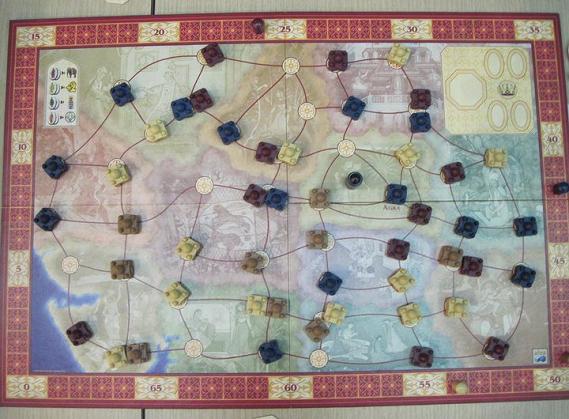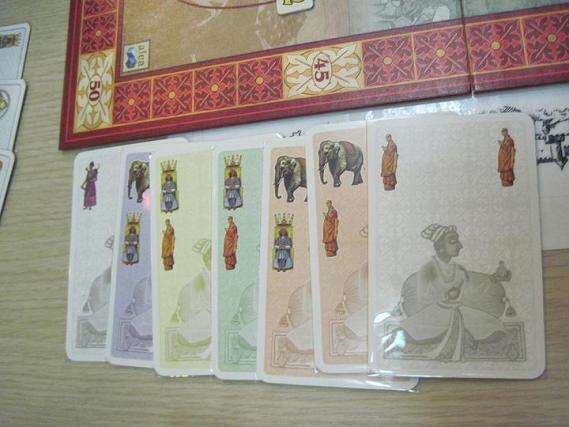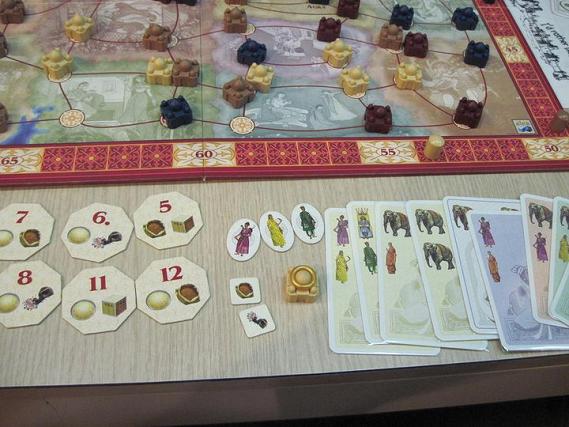
Like Amun-Re, Taj Mahal is one of the more elaborate Knizia games I’ve played. Like so many of his games, this one has an auction system at its heart. In this case, however, instead of money, each player draws and places cards with symbols on them denoting what they can get from each auction. To make things more complex, the cards come in five suits and once you’ve played a card of a color, you can only follow up your “bid” with cards of the same color. The exception are the white colored cards which act as wild cards and can be combined with any other suit.
A player can choose to fold instead of adding cards to his bid. When he does so, he gets whatever goods corresponding to the symbols that he has the most of on the table. Then all of his cards are removed from the table. There are basically two things to aim for here. The big prize is having the most elephants, which gets you a tile that shows multiple goods on it. This gets increasingly valuable as the game goes on. The other prize are having the most symbols for each of the characters. This allows you to place a palace on the board and you score points by building chains of them across provinces.
Winning one of the characters in an auction also gets you that character token, and you can turn in two of them to get a reusable white card unique to each of the four characters. The king character is an exception and getting him allows you to place a second palace, even in a location already occupied by a palace. Finally, some spaces on the board has bonus tiles which are awarded to the player who builds a palace there. That’s the gist of the game. Some thoughts:

- I ended up winning this game. I’m still not quite sure how as I normally do quite badly in them. I came in dead last in Amun-Re. I think it was because I managed to get some early goods tiles without much competition as the others haven’t yet understood how valuable they were and Sean decided to pass for a couple of turns to draw cards rather than bid on anything. Later on, people aggressively played elephant symbols and it was quite expensive to win those tiles.
- I also earned a good deal of points from connecting palaces though I didn’t really plan on it explicitly. I agonized for a bit over whether to place palaces in such as way as to maximize future connection opportunities or to grab bonus tiles when they available. I simply decided to go for the bonus tiles so I was surprised to still be able to make as long a connection as I did.
- The auction mechanics really are quite interesting. Most cards have two sets of symbols on them even if people are actually after just one of the objects up for auction. This means that when you win something, you’re also frequently tied with other players for something else. So when you bow out of an auction, you’re actually doing the other players a favor by making it easier to get a majority of symbols. I didn’t realize this at first and used more cards than necessary in my bids when I should have taken noted of when other players were planning to drop out and plan accordingly.
- The special white cards were not as big a deal as I thought they would be. They’re very helpful but you’re limited to only one of these cards per auction and they tend to move between players a lot. It’s next to impossible to aim to get one of these too, so they’re just an extra bonus for doing something that you wanted to do anyway.
Overall, I like this game quite a bit more than Amun-Re. I don’t like blind bids at all and there’s very little chaos in Taj Mahal. There’s luck involved in the cards sure, but most of the cards you get are drawn from the open pile and taking note of what other players have picked up is part of the game. It’s not enough to make me a Knizia fan but it’s a game I’m perfectly happy to play.

Leave a Reply